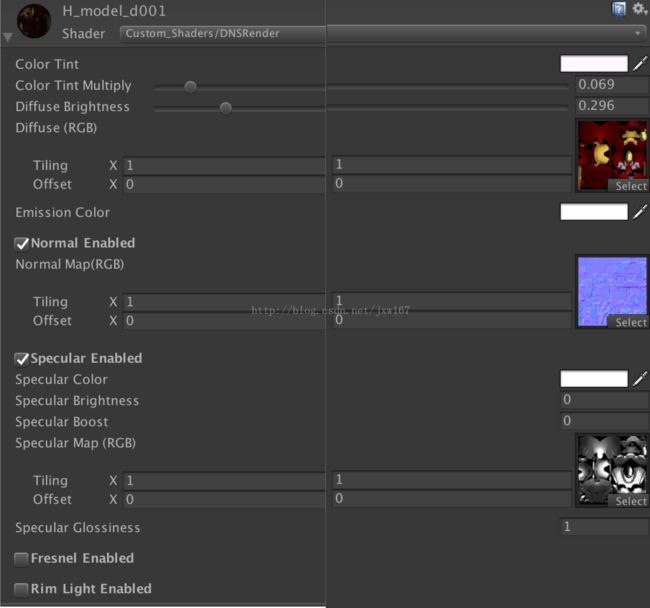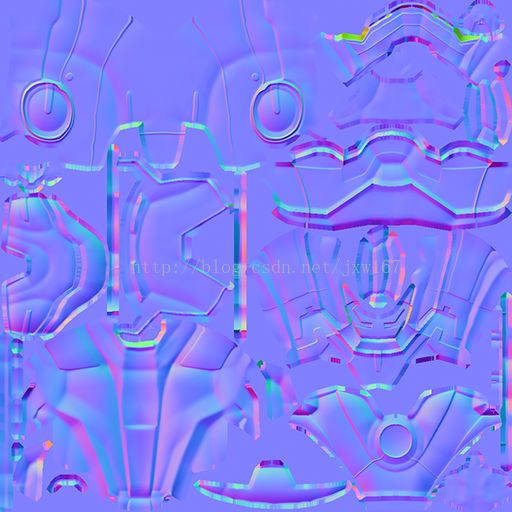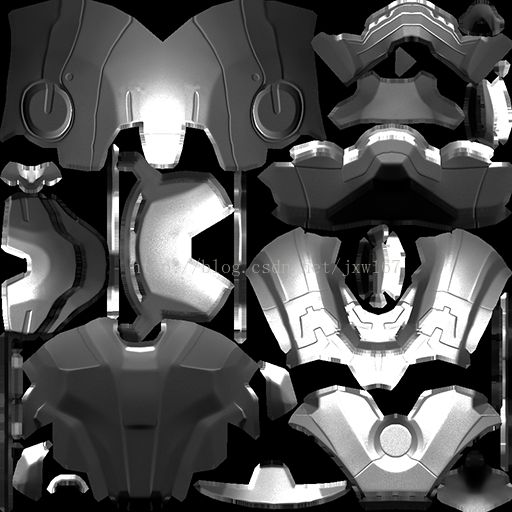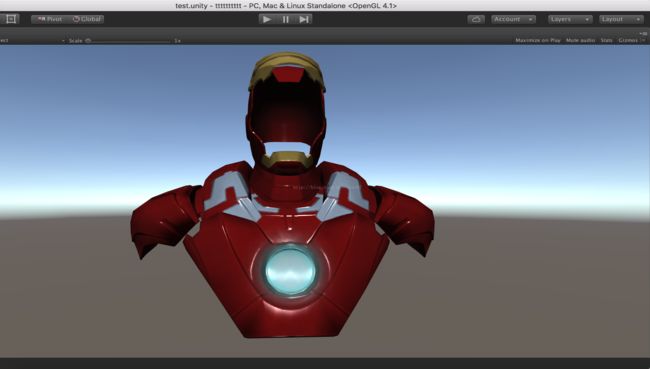Unity3D引擎之高级渲染技术
笔者介绍:姜雪伟,IT公司技术合伙人,IT高级讲师,CSDN社区专家,特邀编辑,畅销书作者,国家专利发明人,已出版书籍:《手把手教你架构3D游戏引擎》电子工业出版社 和《Unity3D实战核心技术详解》电子工业出版社等书籍
在游戏开发中尤其对于角色的材质渲染一直是被游戏开发者所看重,也成为衡量游戏品质的一个指标,关于渲染就需要考虑到Shader编程,Shader主要是对模型的顶点和模型的材质图片做处理,下面告诉读者如何去编写Shader。
在公司,策划需求提出用Unity3D引擎实现角色材质高光、法线效果。策划需求提出后,美术首先用PS和MAX工具将模型制作出来,MAX中有自身带的Shader,它可以完整的实现高光、法线效果,这也是程序编写和调试Shader时的参照依据,程序是参照MAX中的效果去调试,程序实现的效果只能无限接近MAX工具制作的效果。Unity5.4以上版本也有自己的高光法线Shader,但是在使用时效果并不理想,不如自己去实现一下。在这里首先需要提供三张贴图:Diffuse(原图),Specular(高光),Normal(法线)。
接下来就需要对其进行Shader编程实现,为了让美术调试方便,在这里我们使用了控制面板。首先实现一个继承于Materal类的编辑器脚本,将其放到Editor文件夹下面,内容如下所示:
using System.Collections.Generic;
using UnityEngine;
using UnityEditor;
using System.Linq;
using System.Text.RegularExpressions;
public abstract class CustomMaterialEditor : MaterialEditor
{
public class FeatureEditor
{
// The name the toggle will have in the inspector.
public string InspectorName;
// We will look for properties that contain this word, and hide them if we're not enabled.
public string InspectorPropertyHideTag;
// The keyword that the shader uses when this feature is enabled or disabled.
public string ShaderKeywordEnabled;
public string ShaderKeywordDisabled;
// The current state of this feature.
public bool Enabled;
public FeatureEditor(string InspectorName, string InspectorPropertyHideTag, string ShaderKeywordEnabled, string ShaderKeywordDisabled)
{
this.InspectorName = InspectorName;
this.InspectorPropertyHideTag = InspectorPropertyHideTag;
this.ShaderKeywordEnabled = ShaderKeywordEnabled;
this.ShaderKeywordDisabled = ShaderKeywordDisabled;
this.Enabled = false;
}
}
// A list of all the toggles that we have in this material editor.
protected List Toggles = new List();
// This function will be implemented in derived classes, and used to populate the list of toggles.
protected abstract void CreateToggleList();
public override void OnInspectorGUI ()
{
// if we are not visible... return
if (!isVisible)
return;
// Get the current keywords from the material
Material targetMat = target as Material;
string[] oldKeyWords = targetMat.shaderKeywords;
// Populate our list of toggles
//Toggles.Clear();
Toggles = new List();
CreateToggleList();
// Update each toggle to enabled if it's enabled keyword is present. If it's enabled keyword is missing, we assume it's disabled.
for(int i = 0; i < Toggles.Count; i++)
{
Toggles[i].Enabled = oldKeyWords.Contains (Toggles[i].ShaderKeywordEnabled);
}
// Begin listening for changes in GUI, so we don't waste time re-applying settings that haven't changed.
EditorGUI.BeginChangeCheck();
serializedObject.Update ();
var theShader = serializedObject.FindProperty ("m_Shader");
if (isVisible && !theShader.hasMultipleDifferentValues && theShader.objectReferenceValue != null)
{
float controlSize = 64;
EditorGUIUtility.labelWidth = Screen.width - controlSize - 20;
EditorGUIUtility.fieldWidth = controlSize;
Shader shader = theShader.objectReferenceValue as Shader;
EditorGUI.BeginChangeCheck();
// Draw Non-toggleable values
for (int i = 0; i < ShaderUtil.GetPropertyCount(shader); i++)
{
ShaderPropertyImpl(shader, i, null);
}
// Draw toggles, then their values.
for (int s = 0; s < Toggles.Count; s++)
{
EditorGUILayout.Separator();
Toggles[s].Enabled = EditorGUILayout.BeginToggleGroup(Toggles[s].InspectorName, Toggles[s].Enabled);
if (Toggles[s].Enabled)
{
for (int i = 0; i < ShaderUtil.GetPropertyCount(shader); i++)
{
ShaderPropertyImpl(shader, i, Toggles[s]);
}
}
EditorGUILayout.EndToggleGroup();
}
if (EditorGUI.EndChangeCheck())
PropertiesChanged ();
}
// If changes have been made, then apply them.
if (EditorGUI.EndChangeCheck())
{
// New list of key words.
List newKeyWords = new List();
// If true, add the enabled keyword (ending with _ON), if false, add the disabled keyword(ending with _OFF).
for(int i = 0; i < Toggles.Count; i++)
{
newKeyWords.Add(Toggles[i].Enabled ? Toggles[i].ShaderKeywordEnabled : Toggles[i].ShaderKeywordDisabled);
}
// Send the new list of keywords to the material, this will define what version of the shader to use.
targetMat.shaderKeywords = newKeyWords.ToArray ();
EditorUtility.SetDirty (targetMat);
}
}
// This runs once for every property in our shader.
private void ShaderPropertyImpl(Shader shader, int propertyIndex, FeatureEditor currentToggle)
{
string propertyDescription = ShaderUtil.GetPropertyDescription(shader, propertyIndex);
// If current toggle is null, we only want to show properties that aren't already "owned" by a toggle,
// so if it is owned by another toggle, then return.
if (currentToggle == null)
{
for (int i = 0; i < Toggles.Count; i++)
{
if (Regex.IsMatch(propertyDescription, Toggles[i].InspectorPropertyHideTag , RegexOptions.IgnoreCase))
{
return;
}
}
}
// Only draw if we the current property is owned by the current toggle.
else if (!Regex.IsMatch(propertyDescription, currentToggle.InspectorPropertyHideTag , RegexOptions.IgnoreCase))
{
return;
}
// If we've gotten to this point, draw the shader property regulairly.
ShaderProperty(shader,propertyIndex);
}
}
上面是我们自己实现的可以作为父类使用,其实就是做了一个接口封装,下面代码是自己定义的为我们自己的Shader脚本操作写的几个开关。如下所示:
using System.Collections.Generic;
using UnityEngine;
using UnityEditor;
public class EditorInspector : CustomMaterialEditor
{
protected override void CreateToggleList()
{
Toggles.Add(new FeatureEditor("Normal Enabled","normal","NORMALMAP_ON","NORMALMAP_OFF"));
Toggles.Add(new FeatureEditor("Specular Enabled","specular","SPECULAR_ON","SPECULAR_OFF"));
Toggles.Add(new FeatureEditor("Fresnel Enabled","fresnel","FRESNEL_ON","FRESNEL_OFF"));
Toggles.Add(new FeatureEditor("Rim Light Enabled","rim","RIMLIGHT_ON","RIMLIGHT_OFF"));
}
}
相对来说比较简单,它只是做了几个Toggle作为Shader脚本中的控制。将上述两个文件拖放到Editor文件夹下面。
下面才开始真正的Shader编写工作,在这里我们使用了SurfaceOutput作为我们的输出结构体,SurfaceOutput简单地描述了surface的属性( properties of the surface ),如反射率颜色(albedo color)、法线(normal)、散射(emission)、镜面反射(specularity )等。首先定义一个输入结构体如下所示:
struct Input
{
float2 uv_DiffuseMap;
#if SPECULAR_ON
float2 uv_SpecMap;
#endif
#if NORMALMAP_ON
float2 uv_NormalMap;
#endif
#if FRESNEL_ON || RIMLIGHT_ON
float3 viewDir;
#endif
};
结构体中包含 Diffuse贴图的uv坐标uv_DiffuseMap,高光的uv坐标uv_SpecMap,法线的uv坐标uv_NormalMap,另外还定义了一个方向值viewDir。接下来就是实现主函数surf了,对于高光法线的渲染就在这里面了,它调用了大量的CG库函数,如下所示:
void surf (Input IN, inout SurfaceOutput o)
{
float3 TexData = tex2D(_DiffuseMap, IN.uv_DiffuseMap);
float3 _BlendColor = _TintColor.rgb * _TintColorMultiply;
o.Albedo.rgb = _Brightness * lerp(TexData, _TintColor.rgb, _TintColorMultiply) ;
#if SPECULAR_ON
o.Specular = _Gloss;
o.Gloss = max(_SpecAdd + _SpecularMultiply, 1.0) * tex2D (_SpecMap, IN.uv_SpecMap);
//o.Emission = _Gloss * tex2D (_SpecMap, IN.uv_SpecMap);
#endif
#if NORMALMAP_ON
o.Normal = UnpackNormal(tex2D(_NormalMap, IN.uv_NormalMap));
#endif
#if FRESNEL_ON && SPECULAR_ON || RIMLIGHT_ON
float facing = saturate(1.0 - max(dot(normalize(IN.viewDir), normalize(o.Normal)), 0.0));
#if FRESNEL_ON && SPECULAR_ON
float fresnel = max(_FresnelBias + (1.0-_FresnelBias) * pow(facing, _FresnelPower), 0);
fresnel = fresnel * o.Specular * _FresnelMultiply;
o.Gloss *= 1+fresnel;
#endif
#if RIMLIGHT_ON
float rim = max(_RimBias + (1.0-_RimBias) * pow(facing, _RimPower), 0);
rim = rim * o.Specular * _RimMultiply;
o.Albedo *= 1+rim;
#endif
#endif
}
下面将Shader的完整代码展示如下:
Shader "Custom_Shaders/DNSRender"
{
Properties
{
_TintColor ("Color Tint",color) = (1.0,1.0,1.0,1.0)
//Diffuse Sliders
_TintColorMultiply("Color Tint Multiply", Range(0.0, 1.0)) = 0.0
_Brightness ("Diffuse Brightness", Range(0.0, 2.0)) = 1.0
_DiffuseMap ("Diffuse (RGB)", 2D) = "white" {}
_NormalMap ("Normal Map(RGB)", 2D) = "bump" {}
_SpecColor ("Specular Color", Color) = (0.5, 0.5, 0.5, 1)
_SpecularMultiply ("Specular Brightness",float) = 1.0
_SpecAdd ("Specular Boost", float) = 0
_SpecMap ("Specular Map (RGB)", 2D) = "grey" {}
_Gloss ("Specular Glossiness", float) = 0.5
_FresnelPower ("Fresnel Power",float) = 1.0
_FresnelMultiply ("Fresnel Multiply", float) = 0.2
_FresnelBias ("Fresnel Bias", float) = -0.1
_RimPower ("RimLight Power",float) = 1.0
_RimMultiply ("RimLight Multiply", float) = 0.2
_RimBias ("RimLight Bias", float) = 0
_EmissionColor("Emission Color", color) = (1.0,1.0,1.0,1.0)
}
SubShader
{
Tags { "RenderType"="Opaque" }
LOD 300
CGPROGRAM
#pragma surface surf BlinnPhong
#pragma target 3.0
#pragma shader_feature NORMALMAP_ON NORMALMAP_OFF
#pragma shader_feature SPECULAR_ON SPECULAR_OFF
#pragma shader_feature FRESNEL_ON FRESNEL_OFF
#pragma shader_feature RIMLIGHT_ON RIMLIGHT_OFF
float3 _TintColor;
float _TintColorMultiply;
float _Brightness;
sampler2D _DiffuseMap;
sampler2D _NormalMap;
sampler2D _SpecMap;
float _SpecularMultiply;
float _SpecAdd;
float _Gloss;
float _FresnelPower;
float _FresnelMultiply;
float _FresnelBias;
float _RimPower;
float _RimMultiply;
float _RimBias;
float3 _EmissionColor;
struct Input
{
float2 uv_DiffuseMap;
#if SPECULAR_ON
float2 uv_SpecMap;
#endif
#if NORMALMAP_ON
float2 uv_NormalMap;
#endif
#if FRESNEL_ON || RIMLIGHT_ON
float3 viewDir;
#endif
};
void surf (Input IN, inout SurfaceOutput o)
{
float3 TexData = tex2D(_DiffuseMap, IN.uv_DiffuseMap);
float3 _BlendColor = _TintColor.rgb * _TintColorMultiply;
o.Albedo.rgb = _Brightness * lerp(TexData, _TintColor.rgb, _TintColorMultiply) ;
#if SPECULAR_ON
o.Specular = _Gloss;
o.Gloss = max(_SpecAdd + _SpecularMultiply, 1.0) * tex2D (_SpecMap, IN.uv_SpecMap);
//o.Emission = _Gloss * tex2D (_SpecMap, IN.uv_SpecMap);
#endif
#if NORMALMAP_ON
o.Normal = UnpackNormal(tex2D(_NormalMap, IN.uv_NormalMap));
#endif
#if FRESNEL_ON && SPECULAR_ON || RIMLIGHT_ON
float facing = saturate(1.0 - max(dot(normalize(IN.viewDir), normalize(o.Normal)), 0.0));
#if FRESNEL_ON && SPECULAR_ON
float fresnel = max(_FresnelBias + (1.0-_FresnelBias) * pow(facing, _FresnelPower), 0);
fresnel = fresnel * o.Specular * _FresnelMultiply;
o.Gloss *= 1+fresnel;
#endif
#if RIMLIGHT_ON
float rim = max(_RimBias + (1.0-_RimBias) * pow(facing, _RimPower), 0);
rim = rim * o.Specular * _RimMultiply;
o.Albedo *= 1+rim;
#endif
#endif
}
ENDCG
}
CustomEditor "EditorInspector"
}
将Shader挂接到材质球上效果如下:

最终展示效果如下所示:



